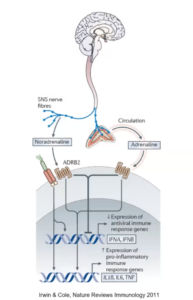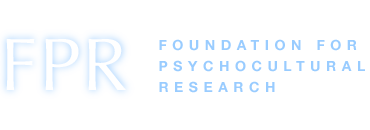Social Regulation of Gene Expression
Steve Cole, PhD
FPR CMB Network Meeting
Moderated by Jeff Snodgrass via Zoom
January 14, 2022
SUMMARY
Background / Neuro- and Immunoregulatory Pathways
- In early 2000s, microarray technology allowed us to screen activity of entire genome at one point in time.
- Steve’s initial 2007 DNA microarray analysis identified 209 genes that differentially transcribed RNA in circulating white blood cells of 14 persons experiencing high vs low levels of social isolation.

- Subsequent studies noted same immune system deviation in low SES, cancer diagnosis, discrimination, chronic stress, low social rank, early life adversity, etc., i.e., not just unique to loneliness.
- Mechanisms explored over next decade, mainly involved the SNS-mediated fight or flight response (Irwin & Cole, Nature Reviews Immunology, 2011):https://doi.org/10.1038/nri3042

- Stress or adversity results in HPA/SNS “fight or flight.” The corresponding changes in transcriptional activity affect the immune system, via stem cell activity in bone marrow, esp. an increase in pro-inflammatory monocytes.
- In response to a question from Carol, Steve said that, from a developmental standpoint, the system is tuned differently in at least two ways: (1) more pronounced in middle and old age and (2) via accelerated aging. More adversity at an early age speeds up the responsiveness to external stressors.
- Steve and colleagues narrowed activity in white blood cells to myeloid lineage immune cells, i.e., monocytes (“first responders”), dendritic cells, and neutrophils, i.e., a relatively small percentage of total white cells.
- These cells are basically “live fast and die young” operators, requiring constant replenishment. The norepinephrine released in bone marrow stimulates stem cell replenishment of monocytes (which depends on expression of RNA messages via neurotransmitters). Stress-responding monocytes can result in systemic inflammation in lungs, arteries, CNS, and in existing tumors to trigger metastasis.
- Why is there more inflammation and less antiviral response in the experience of adverse conditions? Steve said that that distinction is “a fundamental pivot.” The immune system can’t do an optimal job at both, i.e., inflammation is at the expense of the antiviral response.
- In response to a question from Guillaume, Steve said environmental changes can redirect or reverse the lineage / reduce the inflammation profile.
- In response to a question from Margie re the possibility of tracing birth outcomes to the stress conditions of the grandmother, Steve said that’s a different process. Gene regulation involving epigenetic changes, to which Margie was referring, blocks turning on or off of genes, which leads to environmentally induced changes in egg cell biology. But there are a lot of ways to affect this transmission. Family microculture and outlooks strongly structure our self-efficacy and how much we trust people in the world, which can significantly bias fight-or-flight biology.
- Thus far Steve was describing a fundamental mechanism against physical injury, Shinobu wondered how we connect physical injury to the social, and suggested that either (1) the process involves some sort of probability/social learning, or (2) we, and possibly even rodents, have a symbolic representation of injury that metaphorically extends to social images of the self.
- Except, Steve said, this extension of the brain crucially includes what we care about and in particular the need to preserve our goals and values in the face of threat. Threat biology predates dopamine, and represents the need to be ready to pivot to fight microbes.
- “How should we live?”
- Steve discussed his work with Barbara Fredrickson (Fredrickson et al., 2013) on the conserved transcriptional response to adversity (CTRA; the physiological pattern “characterized by up-regulated expression of genes involved in inflammation and down-regulated expression of genes involved in Type I interferon responses,” Cole, 2019), which included a measurement of (social) eudaimonia (well-being beyond self-gratification).
- Eudaimonia (life has direction and meaning, we can grow and become better people) and hedonia (happiness, satisfaction) may appear to be similar, but at the gene regulation level, there are differences. Having a sense of meaning in life is connected to a certain gene signature (anti-viral vs. inflammatory), although at the level of conscious experience of eudaimonic vs. hedonic wellbeing was not significantly different.
- One of the most surprisingly robust findings across cultural contexts: Sense of meaning or purpose in life is powerfully correlated with reduced activity of CTRA mRNA expression.
- How? Neural substrates of eudaimonia essentially veto threat biology (enough to downregulate of activity of inflammatory, anti antiviral system) as long as you are focused on what you care about. Specifically, the ventral striatum (an area hijacked by drugs of abuse) – a driver of discovery and creativity, hoping, seeking, wanting, and play – has direct neural crosstalk with areas of brain/SNS associated with threat response.
- Steve talked about his recent work (Cole, PNAS, 2021) on the COVID lockdown and intergenerational caregiving, looking at male macaques that were socially isolated for two weeks as a proxy for loneliness and shelter-in-place, noting the impairment in Type I interferon antiviral gene expression. When a male juvenile macaque was introduced in a second round of the experiment, the adult male “showed comparable reductions in circulating immune cell populations but reversal of Type I IFN reductions and classical monocyte increases observed during individual isolation.”
- Steve also talked about Brandon’s work with former Nepali child soldiers (Kohrt et al., PNAS, 2016), which showed that people who had higher resilience and a sense of meaning had the lowest threat-related signature in their white blood cells (despite PTSD).
- Steve said researchers have done work on mammalian life, including maternal care, which may necessitate neurobiology that emphasizes bonding or positive motivation biology, cf. Stephen Porges. The parasympathetic nervous system – which “pushes back hard against the SNS (and vice versa) – may be a primary mediator for kin, progeny, and caregiving, shifting away from fight-or-flight stress biology to a default that is strongly anti viral and anti-inflammatory.
- Carol commented that this is exactly what Buddhists say. Steve agreed, they have managed to pencil out what actually works in real life without the details. Tanya said that she loves how purpose and meaning affect biology, but how is this measured? Steve said, in as many ways as we can. He said that researchers have used questionnaires (self-report) with defensible psychometric properties, which gave initial hints of what seems to be going on.
- Steve recalled a previous slide of the eudaimonic-hedonic circle with favorable-adverse poles and a previous slide on “A eudaimonic route to CTRA reduction” that graphically showed CTRA reduction in research participants after they engaged in intergenerational mentoring or acts of kindness. He suggested not asking the research participants what they think – have them do something. You can get some RNA readout of eudaimonic grandmothers and eudaimonic college students.
- Steve then recalled a previous slide of an adult monkey in lockdown. Tanya said that this sets up ethnographers to look at what kinds of care are effective and useful. Steve recalled previous bar chart slides on former Nepali child soldiers and cautioned that nothing works uniformly well with everyone, with regard to interventions.
- With regard to the slide that included a citation of his research with Cole on Japanese IT workers, Shinobu said that study found that interdependence at the workplace is a strong predictor of downregulation of CTRA. Is it because of Japan, or something more general? Shinobu said it is probably found in monkeys and in the US, too. Threat and security are evolutionary considerations that are grounded in physiology. Sense of threat is linked to physical injury (threat) and security (social bonding). Steve said he would amend that to generativity, diseases.
- Shinobu also noted that the ventral striatum is not unique to social bonding per se. Steve mentioned the work of Naomi Eisenberger, who looked at value affirmation using MRI. She found high subjectivity in valued concepts. Shinobu mentioned the work of Brian Knutson, which implicates ventral striatum in the anticipation of money. Steve said that in mice, the ventral tegmental area can be activated with drugs, which leads to change in sympathetic nervous system activity and gene regulation (molecular genetic tricks), so it may not matter what activates the ventral striatum.
- Finally, Steve mentioned Walter Cannon and Hans Selye’s views of stress, threats to you and your survival, but threat biology is about defending what we care about. Maybe the organizing principle of brain is what matters in threat biology.
DISCUSSION
Greg asked, is there anything elsewhere that is comparable to this level of detail (stress and inflammation)? Steve said, no at the moment. There is a ton of scaffolding in stress. It’s easier to make people healthy rather than to stop them from being sick. Steve also said people are generous with their white blood cells but there may be other parts of the body that can show effects of threat.
Brandon talked about his own work on the longitudinal IDEA project [NB: Identifying Depression Early in Adolescence], which looks at associations of depression. This project has found that loneliness precedes depression. The work is being conducted in South Africa, Nepal, and Brazil. Brandon said that therapies are more social support. There is not much therapy that is about doing good acts in the world (i.e., outward facing). Steve said to think expansively of therapy and get people plugged into the world. Steve said acceptance therapy is a component of this. Steve said he has been tapped as a loneliness expert. In terms of therapy, what has worked well is to have lonely people not from a deficit perspective but see them as contributive and into the community, e.g., involve them in a cause like saving whales. In lonely people, Cole said there is an abiding mistrust in people. Beyond saving a whale, may I borrow a cup of sugar? This therapy is a remedial experience, akin to physical rehabilitation. Alternatively, Steve said put into practice without labeling. He mentioned the gerontology work of Teresa Seeman. Seeman’s work showed that forming shared bonds helps to combat negative effects of aging, putting the focus on generativity and helping young people.
Suparna had questions about adolescence. Steve said that is the peak period of physiological functioning, where you can see fingerprints of adversity in early life. Carol said Steve did not talk of caregiving and ACEs [NB: adverse childhood experiences] and how we construct that. Cole said people do caregiving much less. He said caregiving used to be cone in community settings but nowadays, caregiving is commodified.
Readings (thanks to Jeff Snodgrass!)
Cohn, M. A., Fredrickson, B. L., Brown, S. L., Mikels, J. A., & Conway, A. M. (2009). Happiness unpacked: Positive emotions increase life satisfaction by building resilience. Emotion, 9(3), 361-368. https://doi.org/10.1037/a0015952 / pdf
Fredrickson, B. L., Grewen, K. M., Algoe, S. B., Firestine, A. M., Arevalo, J. M., Ma, J., & Cole, S. W. (2015). Psychological well-being and the human conserved transcriptional response to adversity. PLoS One, 10(3), e0121839. https://doi.org/10.1371/journal.pone.0121839 / pdf
Keyes, C. L. M. (2014). The mental health continuum: From languishing to flourishing in life. Journal of Health and Social Behavior, 43(2), 207–222. / pdf
Lamers, S. M., Westerhof, G. J., Bohlmeijer, E. T., ten Klooster, P. M., & Keyes, C. L. (2011). Evaluating the psychometric properties of the Mental Health Continuum-Short Form (MHC-SF). Journal of Clinical Psychology, 67(1), 99-110. https://doi.org/10.1002/jclp.20741 / pdf
Ryff, C. D. (1989). Happiness is everything, or is it? Explorations on the meaning of psychological well-being. Journal of Personality and Social Psychology, 57(6), 1069–1081. / pdf
Ryff, C. D., & Singer, B. H. (2006). Know thyself and become what you are: A eudaimonic approach to psychological well-being. Journal of Happiness Studies, 9(1), 13–39. https://doi.org/10.1007/s10902-006-9019-0 / pdf
Snodgrass, J. G., Lacy, M. G., Dengah, H. J. F. I., Polzer, E. R., Else, R. J., Arevalo, J. M. G., & Cole, S. W. (2019). Positive mental well-being and immune transcriptional profiles in highly involved videogame players. Brain, Behavior, and Immunity, 82, 84–92. / pdf


